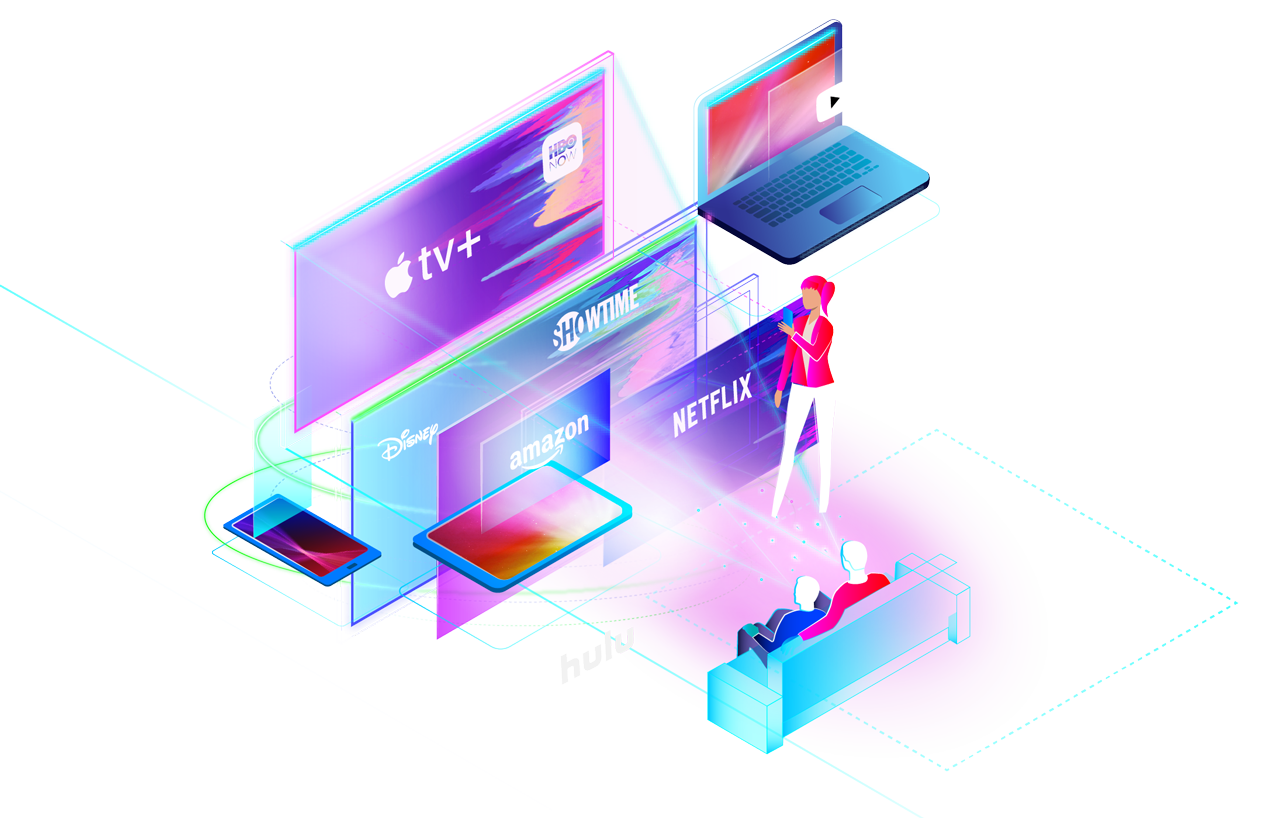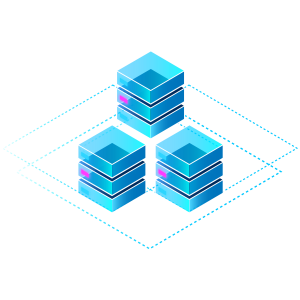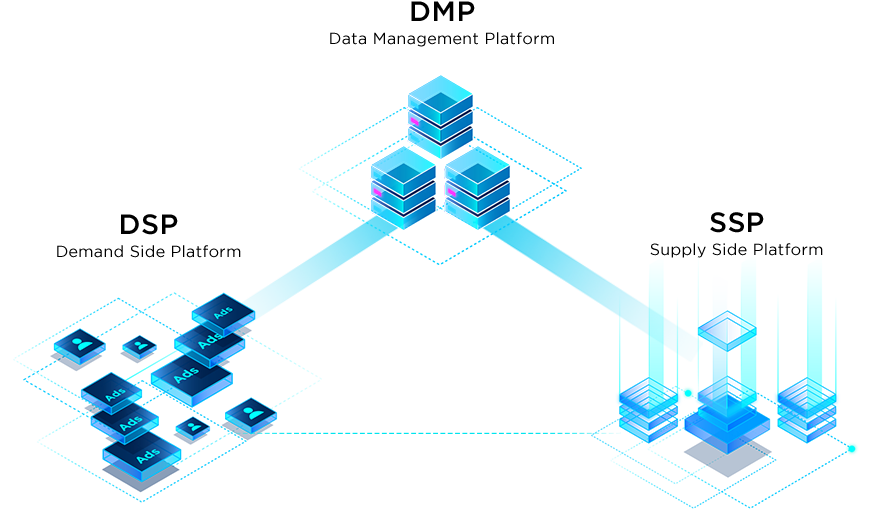Connected TV Advertising is becoming ubiquitous. If you’re watching TV online or you have a TV that is hooked up to the internet that allows you to stream video content, you’re using Over the Top media or Connected TV.
74% of U.S. homes now report having at least one connected TV device. Smart TVs with Wi-Fi or internet capabilities, standalone streaming players, streaming adapters and sticks, and gaming consoles are more common than ever. More than half of U.S. homes now have three or more connected TV devices.
74% of U.S. homes now report having at least one connected TV device. Share on XFor an advertiser, this offers a new way to target potential customers using powerful ad tech tools to optimize your advertising.
Connected Television Advertising Technology
The technological advancements in internet technologies and software during the past two decades have given rise to modern CTV ad tech. Connected TV Advertising is gaining in popularity among advertisers because this sophisticated technology has surpassed the technical capabilities of linear TV.

Unlike traditional broadcast or cable TV, connected TV advertising uses advanced networking technologies. CTV leverages ad tech such as Dynamic Ad Insertion (DAI) and Server-Side Ad Insertion (SSAI). This allows for precise targeted, context, and relevancy.
DAI or SSAI creates an individual media stream for each unique viewer. When there’s a place for an ad unit, the server will analyze known data about the individual, including demographics, past viewing history, behavioral, contextual, and geographic information to serve the most relevant ad that’s most likely to convert. This highly precise targeting means more relevant ads are served.
It produces a better ROAS (Return on Ad Spending) for advertisers.
When DAI or SSAI is used, this delivery tech “stitches” ad units seamlessly into the program stream. This avoids being detected by ad blockers that react to specific ad calls. Some CTV Ad servers will use a different method for delivery, which takes place on the client-side. In this case, video content flows through a Content Delivery Network (CDN) while ad calls insert separate ads from third-party ad servers. Both delivery mechanisms provide advanced targeted that linear TV can’t do.
By comparison, linear TV can only target by ratings and broad demographic categories.
On linear television, every viewer watching will see the same ad unit. Two people watching the same content on CTV can be served entirely different ads relevant to each individual.
Also, CTV provides enhanced measurement and attribution. CTV can measure ad delivery and connect it to online behavior and conversions. CTV marketers can identify when viewers take action after seeing CTV ads, such as visiting a website and making a purchase. Linear TV can only provide broad demographic categories for viewing and cannot track behavior between multiple devices.
Marketers running Connected TV Ads can identify when viewers take action after seeing CTV ads, such as visiting a website and making a purchase. Share on XHow Connected TV Advertising works?
Buying CTV ads work similarly to other digital advertising, but the alphabet soup of key players in the buying chain can be confusing.
Three main players that manage the ad buying and selling chain: DSPs, DMPs, and SSPs.
Demand Side Platforms (DSPs)

Demand Side Platforms (DSPs) work on the buyer side to provide access to video inventory that’s available on-demand and in live programming. Various publishers make ad inventory available through ad exchanges. DSPs aggregates these exchanges and optimize impressions, which are then made available to buyers.
Data Management Platforms (DMPs)

Data Management Platforms (DMPs) sit in the middle between buyers and sellers and collect first, second, and third-party data to help with targeting. Buyers will choose targets from pre-defined attributes, such as demographics, interests, behaviors, and online history. These targets are used by DSPs to serve relevant ads.
Supply Side Platforms (SSPs)

Supply Side Platforms (SSPs) manage the seller side. Publishers list and manage their inventory using SSPs. They will set minimum price points and make changes as inventory is sold. SSPs facilitates the selling of connected TV advertising impressions through automated auctions. Supply-side platforms compare the rates buyers are willing to pay with the rates publishers are eager to sell. When there’s a match, sales happen.

When someone wants to buy CTV advertising, they will use a DMP to gather audience data on their specific targets. That information is then fed into a DSP with other campaign information, such as price and flight dates. The DSP connects to the SSP and starts shopping.
The DSP will sort through the various ad options publishers have made available at different prices and delivery options. It will determine the best pathway to reach the target audience at the most efficient pricing. The DSP makes an offer based on these parameters If it’s acceptable to the SSP, the ad is bought and subsequently delivered.
Connected TV is only going to grow.
Clearly, CTV Advertising is the fastest-growing video segment. Advancements in technology directly impact the key players in the demand and supply platform, enhancing their capabilities. There’s been an explosion of internet-connected devices being sold. 5G is on the horizon. That allows for data to be delivered 10 times faster and will only accelerate the growth in connected television.
CTV Advertising is the fastest-growing video segment. Here's how it works. Share on XAs the lines among entertainment devices start to blur and seamless content consumption across different devices is becoming more and more common. With technologies such as IoT, VR, AR, MR that are on the horizon to become mainstream. Just imagine the plethora of integrations and applications they will have in Advertising.
As a marketer, it is wise to incorporate CTV as part of your offering as the demand is quite staggering.
Getting started with CTV can be a daunting endeavor as it is quite resource-intensive. Having to learn and navigate the world of Connected TV can easily get you lost in the weeds. It is wise to get guidance and consulting from experts who have been early adopters of the technology and have strong relationships with the CTV platforms.
While there are a lot of vendors who offer CTV and OTT advertising as part of their marketing services, you’d want to make an informed decision on who you’d work with. Ideally, you should look for organizations who have their hands deep within your vertical so they have a solid understanding of where you come from. And focus on the ones who have the technical caliber to not only build a strategy but also orchestrate and manage the day-to-day ad operations.
You need an expert to navigate the world of Connected TV advertising. An agency like Demand Local can handle your CTV ad buys, OTT ads, and OTT marketing. Using the latest ad tech, we can make sure you get the best solution for your clients and avoid wasting your ad dollars.
Talk to the experts at Demand Local to learn how you can take advantage of our powerful CTV marketing tools.





